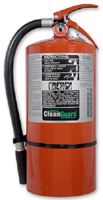



Find all of your laboratory and workplace safety supplies at Safety Emporium!
 ALARA |
 Glossary Index |
 Aliphatic |
| MSDS Topics |
Free Sites | FAQ's | Regulations | Glossary | Software | Suppliers |
| Books | Forum | Poll | Fun stuff | Quiz | Store | |
| Understand your MSDS with the MS-Demystifier | Search ALL our MSDS info | |||||
An alcohol molecule has the general formula ROH where R is an alkyl group, O is an oxygen atom and H is a hydrogen atom. Alcohols can be thought of as analogs of water, H2O, in which one hydrogen atom has been replaced by an alkyl group.

Protect sensitive electronic and laboratory equipment with Ansul CleanGuard extinguishers from Safety Emporium.
"Alcohol" is sometimes used to refer to one specific alcohol, ethanol (also known as ethyl alcohol). See below for further information.
Phenols have a similar formula, ROH, but R is an aryl group.
Just to confuse matters a little bit, the simplest example of a phenol, C6H5OH, is named phenol.
A compound that contains a phenol unit may sometimes be referred to as phenolic as in "phenolic resin".
The molecular structures of some common alcohols and phenols are shown below:

Ethanol (ethyl alcohol) is the alcohol found in alcoholic beverages such as beer and wine. Consumption of ethanol can lead to intoxication (drunkenness) as well as coma and death if too much is consumed. The ethanol content of such beverages is often expressed as proof where 2 proof = 1% alcohol by volume. Therefore, a beverage that is 100 proof is 50% alcohol by volume and 100% pure ethanol is 200 proof. For those who are calculationally impaired or have consumed too much ethanol, here is a convenient conversion calculator:

Ethanol is sold commercially in denatured form, meaning that a small amount of a difficult to remove and toxic material such as benzene has been added. The purpose of this is to prevent people from drinking and/or selling the ethanol. Chemists may buy absolute (200 proof, 100% pure) ethanol, but there are strict oversights and regulations that must be followed. Under no circumstances drink laboratory ethanol, even if it is marked "absolute" as the bottle may have been contaminated during use or storage.

Ethanol is the only alcohol that is "safe" for human consumption. Drinking methanol, isopropanol or denatured ethanol, even amounts as small as an 1 to 2 ounces = 50 ml (see volume units), can lead to blindness, coma and death
Alcohols are generally hygroscopic, meaning that they often contain a fair amount of water. This can be particularly dangerous if you are working with an alcohol and a water-reactive metal such as sodium or potassium.
Alcohols are generally incompatible with acids and other oxidizing agents.

Store your solvents safely with flammable storage safety cabinets from Safety Emporium.
Many alcohols are flammable. Some, such as methanol, burn with an almost invisible flame, so be very careful to avoid heat, flame or other ignition sources and make sure you have a proper fire extinguisher on hand. Numerous injuries to instructors and students have occurred using methanol in classroom demonstrations, a practice that needs to stop.
Many alcohols are very soluble (or even miscible) with water. This chemical similarity with water means that alcohols can readily penetrate your skin. Phenols are particularly dangerous in this regard as many are not only irritants, but are also fairly toxic. Always wear proper personal protective equipment such as gloves, goggles, aprons and/or suits when working with phenols.
Read about not one, but five different people who died after a single skin exposure to a common phenol for which there is no antidote!
Additional definitions from Google and OneLook
Entry last updated: Saturday, February 19, 2022. This page is copyright 2000-2025 by ILPI. Unauthorized duplication or posting on other web sites is expressly prohibited. Send suggestions, comments, and new entry desires (include the URL if applicable) to us by email.
Disclaimer: The information contained herein is believed to be true and accurate, however ILPI makes no guarantees concerning the veracity of any statement. Use of any information on this page is at the reader's own risk. ILPI strongly encourages the reader to consult the appropriate local, state and federal agencies concerning the matters discussed herein.